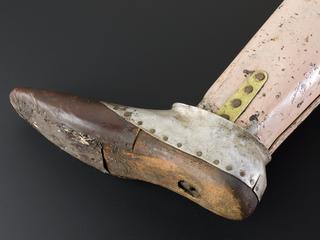
Clothes peg for use with a mechanical substitute for the arms, United Kingdom, 1919
- Made:
- 1919 in United Kingdom

Clothes peg for fork attachment for use with a mechanical substitute for the arms, 1919
These tools and other materials are associated with an invention known as the mechanical substitute for the arms. It was designed and made during the First World War by George Thomson, a Scottish gas fitter. It is an example of one of many technological solutions suggested by members of the public to challenges arising out of the war. Thomson’s invention was made for men who had lost both arms at the shoulders, an extremely rare injury even among the 41,000 British servicemen who lost one or more limbs during the First World War. For a small number, their injuries were so severe that there was no limb stump left on which to attach a functioning artificial limb.
A number of tools, including cutlery, a cup holder and scissors were clipped on to a mechanical arm, which was then attached to an ordinary dining table. The user could operate the arm and tools with foot pedals placed underneath. As well as feeding himself, the trained user could type, write with a modified fountain pen, cut with a knife and scissors and strike a match to light a cigarette. The sheet shows typing and a book contains writing samples from a man using the mechanical arm at Queen Mary’s Hospital, Roehampton, England – the hospital was founded in 1915 to provide wounded servicemen with prosthetic limbs.
Details
- Category:
- Orthopaedics
- Collection:
- Sir Henry Wellcome's Museum Collection
- Object Number:
- A602321/4
- type:
- clothes peg




